The Jieziyuan huapu 芥子園畫譜 "The painting book of the Mustard Seed Garden", also called Jieziyuan huazhuan 芥子園畫傳, is a book on painting compiled by the Qing-period 清 (1644-1911) master Wang Gai 王概 (fl. 1705) and his brothers Wang Shi 王蓍 and Wang Nie 王臬.
The exact dates of the life of Wang Gai, original name Wang Hao 王淏, also written Wang Gai 王改, 王匄 or 王丐, courtesy name Dongguo 東郭 or Anjie 安節, are not known. He was active in the late 17th century, hailed from Xiushui 秀水 (modern Jiaxing 嘉興, Zhejiang) and lived for a long time in Jiangning 江寧 (Nangjing 南京, Jiangsu). Wang Gai had learned painting from the master Gong Xian 龔賢 (1618-1689) and was an expert in large-size paintings (dafu hua 大幅畫) of pines (song 松) and stones (shi 石). His paintings were famous for their intense and vivid style, which was sometimes criticised as exaggerated. It is said that in his illustration of persons and birds (lingmao 翎毛) his movement of the brush had a "taste beyond (common) taste" (wei wai zhi wei 味外之味). When he produced paintings for Zhou Lianggong's 周亮工 (1612-1672) Litatu 禮塔圖 "Ritual pagoda" and Yufotu 浴佛圖 "Washing the Buddha", he created drawings that had an extraordinary touch of antiquity (qigu 奇古) and were very different from the contemporary mainstream of painting. Wang Gai was also renowned for his seal-carving skills. He often included poems or prose texts in his paintings and was, all in all, a highly respected artist of his time. Biographies of him can be found in the local gazetteer Jiangjing fu zhi 江寧府志, the painting book Guochao huazheng lu 國朝畫徵錄 (Qingchao huazheng lu 清朝畫徵錄), and a book on seal-carving, the Guang yinren zhuan 廣印人傳. Wang Gai's older brother Wang Shi, original name Wang Shi 王尸, courtesy name Micao 宓草, was likewise known as an artist painter, particularly in the field of portraits (gonshu工書), and a seal-carver. Wang Nie, original name Wang Nie 王孽, courtesy name Zizhi 司直 or Ruchen 汝陳, was known for his poems.
The Jieziyuan huapu was compiled on the request of Shen Xinyou 沈心友, a son-in-law of the famous poet Li Yu 李漁 (1611-1680). Jieyizuan "Garden as [small as] a mustard seed" was the name of Li Yu's mansion in Nanjing. The book consists of four series (ji 集). The first was written based on a blueprint compiled by the Ming-period 明 (1368-1644) scholar Li Liufang 李流芳 (1575-1629) that consisted of 133 pages with 40 illustrations. The collection was printed as a high-quality coloured woodblock print edition with the support of Li Yu in 1678. It is divided into five chapters (juan "scrolls"), the first explaining the fundamental theories of painting (Huaxue qianshuo 畫學淺說), as well as the use of colours and shadings (Shese 設色), the second chapter (Shupu 樹譜) is dedicated to trees, the third (Shanyanpu 山石譜) to mountains, cliffs and rocks, the fourth (Renwu wuyu pu 人物屋宇譜) to persons and buildings, and the fifth chapter (Mingjia shanshui huapu 名家山水畫譜) presents selected examples of landscape painting from famous masters. Each chapter is divided into several sub-chapters.
The chapter on trees, for instance, includes eighteen various methods to draw trees, thirty-three methods to draw multiple leaves, twenty-nine methods to draw branches of trees in contours (jiaye 夾葉) as well as climbing plants (gouteng 鈎藤), nine methods to draw withered trees (kushu 枯樹), twenty-three methods to draw "various trees" (zashu 雜樹), fifteen methods to draw pines (song 松), cypresses (bai 柏) and willows (liu 柳), and seventeen methods of drawing bananas (jiao 蕉), cinnamom trees (tong 桐), flowers, bamboo and reed (jiatan 葭菼). For each method, at least one illustration is provided and briefly commented on. In the eyes of the author, it was important to note the flow of the "dragon veins" in the painting (lai long qu mai 來龍去脈), and to point out mistakes often occurring in popular painting. The chapter then presents examples of trees and leaves.
The first collection is introduced by two prefaces written by Li Liweng 李笠翁 (i.e., Li Yu) and He Yong 何鏞. The introductory chapter Qingzaitang huaxue jianshuo 青在堂畫學淺説 "Shallow explanation from the Qingzai Hall about the teachings of painting" gives a short overview of the history, styles and techniques of painting, like the "six basic rules" (liufa 六法), the "six requirements and the six features of strength" (liuyao liuzhang 六要六長), the "three failures" (sanbing 三病), the "three classes" (liuzong 三品), the various schools (fenzong 分宗), high-quality painters (zhongpin 重品), how to use brush (yongbi 用筆) and ink (yongmo 用墨), how to create colours (shese 設色), the use of pure silks (juansu 絹素), of paper (zhipian 紙片), the preparation of alumn (fanfa 礬法) or about inscriptions in paintings (luokuan 落款).
The second series was compiled by Zhu Sheng 諸昇 (b. 1618), an expert on bamboo (zhu 竹) and orchids (lan 蘭) from Hangzhou, Wang Zhi 王質 (Wang Yun'an 王蘊庵), a specialist for plums (mei 梅) and chrysanthemums (ju 菊), and the brothers Wang. It is divided into four chapters, each covering one of the four plants.
Wang Zhi and the brothers Wang created the third series. It consists of four chapters, the first (Caochong huahui 草蟲花卉) concentrating on insects and creeping animals between grass and flowers. The second (Lingmao huahui 翎毛花卉) discusses the painting of birds and a few mammals amidst vegetation.
The second and third series were published as coloured woodblock prints in 1701. These two series are also introduced by a theoretical introduction, with some poems and formulas (gejue 歌訣) on painting, and include many examples created by famous painters. The second collection is dedicated to orchids, bamboo, plums and chrysanthemums. It is introduced by four prefaces, written by Zhu Sheng (Lanzhupu xu 蘭竹譜序), Yu Chun 余椿 (Meijupu xu 梅菊譜序), Wang Gai (Huazhuan hebian xu 畫傳合編序) and He Xong (Xu 序). The first chapter begins with ten basic rules for painting orchids. Then it explains different methods to draw orchid leaves in one single black curve (pie ye shi 撇葉式), drawing the outlines of leaves with two lines (shuanggou ye shi 雙鉤葉式), hanging leaves (pie ye dao chui shi 撇葉倒垂式), whole flowers (xie hua shi 寫花式), flowers in a few dots (dianxin shi 點心式), the outlines of flowers (shuanggou hua shi 雙鉤花式), and how to sketch whole twigs with flowers (xie huihua 寫蕙花式). Like the first collection, the four chapters of the second one are accompanied at the end of each chapter by famous examples of paintings to be copied and trained. Famous orchid painters were Ma Lin 馬麟, Meng Zhaofu 趙孟頫 and Wen Zhengming 文徵明. The other chapters are compiled similarly.
Exemplary masters of bamboo painting were Li Kan 李衎 (author of the book Zhupu 竹譜), Su Shi 蘇軾 (1037-1101), Wen Tong 文同 (1018-1079) and Wang Mengduan. Masters of plum painting were Yang Buzhi 楊補之 (1097-1169), Wang Mian 王冕 (1287 or 1310-1359), Xu Xi 徐熙 (886-975), Teng Chengyou 滕昌祐 (late 9th cent.), Zhong Ren 仲仁 (late 11th cent.), Zhou Mi 周密 (1232-1298 or 1308) and Xu Chongsi 徐崇嗣 (late 10th cent.), and masters of chrysanthemum painting Huang Jian 黄鑒, Xu Xi, Zhao Yizhai 趙彝齋, Ke Danqiu 柯丹丘 and Zhao Chang.
The third collection is dedicated to the theme of flowers, grasses (hui 卉), "feathers" (ling 翎, i.e., birds) and "hairs" (mao 毛, i.e., birds). It begins with prefaces written by Wang Zehong 王澤弘 and He Zhiding 何之鼎, and includes postfaces by Xie Changnian 謝昌年 and Chao Xun. The collection is divided into two chapters and provides examples of 106 famous paintings. It is accompanied by ten rules for painting flowers and grasses and seven rules for "grasses and insects". As master examples for flowers and birds, the third series shows drawings from paintings of Yi Yuanji 易元吉, Qian Xuan 錢選, Lü Ji 呂紀, Lin Liang 林良, Huang Jucai 黄居寀, Wang Yuan 王淵 and Sheng Mao 盛懋, and concerning other animals, examples of Li Di 李迪, Zhao Bosu 趙伯驌, Cui Bai 崔白, Bian Luan 邊鸞, Cui Que 崔慤 and Qian Xuan 錢選.
Shen Xinyou's idea had been to create four series, but the fourth part was never finished during his lifetime. Some book traders during the Jiaqing reign-period 嘉慶 (1796-1820), therefore, decided to combine some already existing writings to create a fourth series. These were Ding Hao's 丁皋 Xiezhen mijue 寫真秘訣 (also called Chuanzhen xinling 傳真心領) and Shangguan Zhou's 上官周 Wanxiaotang huazhuan 晚笑堂畫傳. These texts were published in 1818 under the title of Jieziyuan huapu 芥子園畫譜. The resulting fourth series consists of three chapters, the first dedicated to the painting of "immortals" (liexian 列仙), the second to "famous worthies" (mingxian 名賢), and the third to "beauties" (meiren 美人). An appendix includes Li Yu's treatise Tuzhang huizuan 圖章會纂.
The fourth collection is introduced by prefaces written by Zhang Mingke 張鳴珂, Huang Xiexun 黄協塤 and Tan Risen 譚日森撰. Chen Changsxhen 陳昌紳, Zou Wangbin 鄒王賓 and Chao Xun compiled the afterwords. The main text first gives an historical overview of the painting of persons and explains the methods and formulas of various ancient masters. It lists 94 exemplary paintings or writings of old masters like Pei Xiaoyuan 裴孝源, Zhang Yanyuan 張彦遠, Guo Xi 郭熙, Mi Fu 米芾, Su Shi 蘇軾, Deng Chun 鄧椿, Chen Yu 陳郁, Wang Yi 王繹, the anonymous Xuanhe huapu 宣和畫譜, Zhao Mengfu 趙孟頫, Tang Zhi 湯穉, Tang Yin 唐寅, Wen Zhengming 文徵明, He Liangjun 何良俊, Wang Luoyu 汪砢玉 or Shen Zongjian 沈宗騫. The compiler selected five texts in which original formulas are described, namely Su Shi's Chuanshenlun 傳神論, Chen Zao's 陳造 Xieshenlun 寫神論, Wang Yi's Xiexiang mijue 寫像秘訣, Shen Jiezhou's 沈芥舟 Lunzhuanshen 論傳神 and Ding Siming's 丁思銘 Xiezhao tigang 寫照提綱. Nearly 40 texts on "secret formulas of perfect painting" are mentioned, and more than a hundred master objects are depicted, ready for testing the reader's skills. Such were created by Wu Daozi 吳道子, Han Gan 韓幹, Guan Xiu 貫休, Li Gonglin 李公麟, Zhao Mengfu, Shen Zhou 沈周, Wen Zhengming, Chen Hongshou 陳洪綬, Gai Qi 改琦, Ren Xiong 任熊 or Ren Yi 任頤.
The Jieziyuan huapu became soon a very popular book and was often reprinted, but only a few copies of these many editions have survived. During the Guangxu reign 光緒 (1875-1908), it was even impossible to find out what the original publications had looked like. The master Chao Xun 巢勛 (1852-1917), therefore, reproduced the first three collections and republished them in 1887 and 1888. In 1897, he brought out a further edition that included the fourth collection as a lithographic print. The fourth series of this edition consists of six chapters, the first chapter presenting theories on the painting of persons, the second formulas to paint deities, and the third consists of the book Xuezhen mijue. Chapters four and five present examples from famous masters that were copied by Chao Xun, and the sixth chapter shows examples from contemporary painters from Shanghai. Chao Xun's edition is today the most easily available version. In 1927, the Youzheng Press 有正書局 reprinted the third collection. The whole book was republished in 1960 by the People's Press 人民出版社, but only in a one-colour edition. In 1982, the Shanghai Shudian published the first three series, likewise in a non-coloured edition.
Chao Xun (1852-1917), courtesy name Ziyu 子余, style Songdaoren 松道人 or Songhuaguan zhu 松華館主, came from Jiaxing, Zhejiang, and had studied painting under Zhang Tai 張熊. He professed in landscape painting, flowers, and birds and was famous for his paintings of old trees and winter crows in the style of Ni Zan 倪瓚 (1301-1374). He has produced a lot of copies of famous Ming and Qing period paintings and left a collection of poems, the Guangxueting zhuxuan ci 光雪廳竹軒詞.
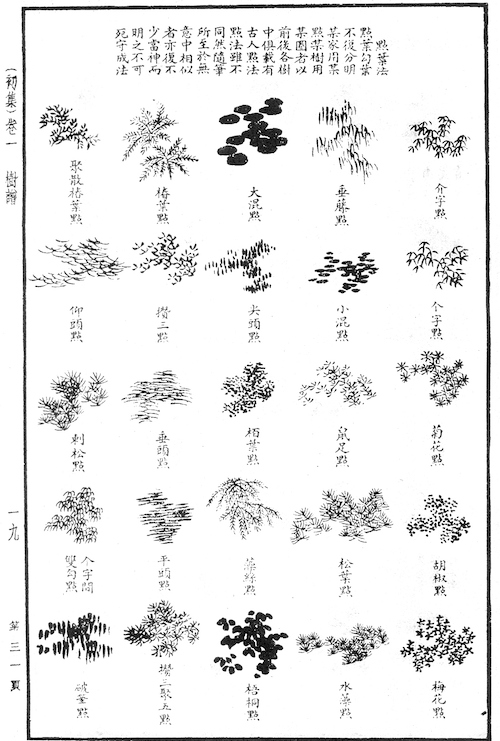 |
 |
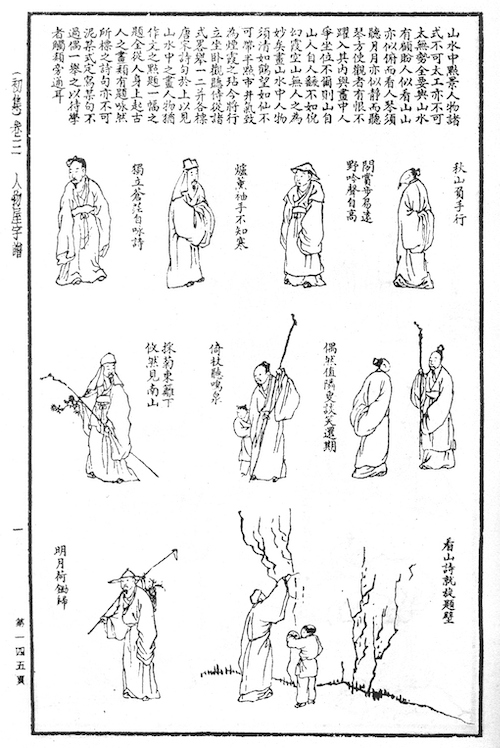 |
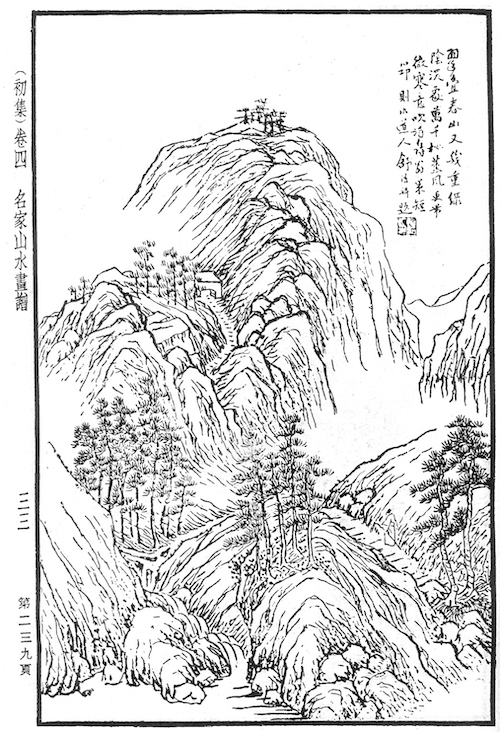 |
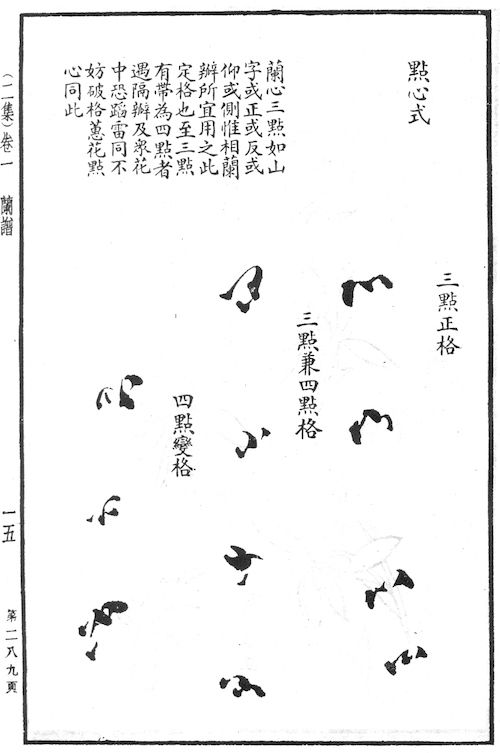 |
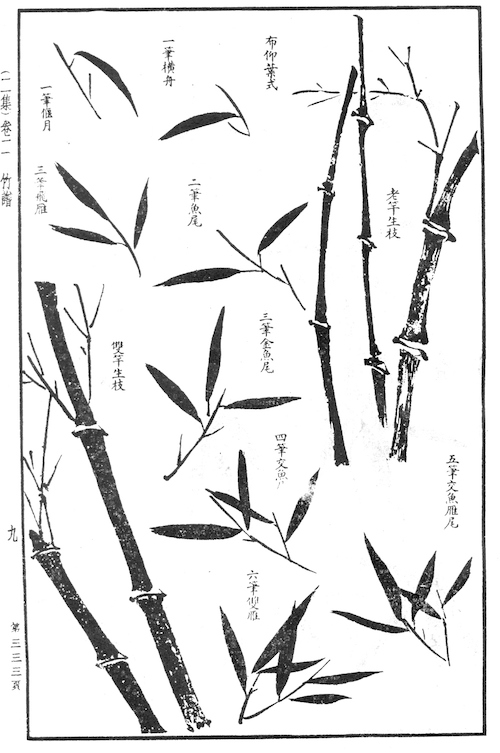 |
Illustrations from the Jieziyuan huapu 芥子園畫譜. From top to bottom: Shapes of various leaves, rocks, persons, a landscape, flowers drawn in dots, bamboo stalks and leaves. |
|
The Jieziyuan huazhuan is a complete overview of the various genres in traditional Chinese painting. Because of the many illustrations included in the book, it became much more popular than any other book on Chinese painting because it could serve as a kind of "textbook" that provided countless examples how to draw the objects appearing in popular-style paintings. It explains the fundamental skills of painting in a very comprehensive and systematic way. The model paintings created by the publishers are very clear and give an excellent overview of the art of painting. They provide ideal templates for the beginner to be copied for training. The Jieziyuan is also a kind of classic analysing the standards of painting. It furthermore includes critical thoughts by the authors and so takes side with the great masters of the Southern Song period 南宋 (1127-1279), the ancestors of what was to become the standard of traditional Chinese painting.
One of the first translations of the Jieziyuan huazhuan in a Western language was produced by the Italian-born French Raphaël Petrucci in 1918 (?), with the title of Kiai-tseu-yuan houa tchouan: Les enseignements de la peinture du jardin grand comme un grain de moutarde, encyclopédie de la peinture chinoise. Paris: Henri Laurens. An English translation has been published by Mai-mai Sze and Michael J. Hiscox. 1956. The Tao of Painting: A Study of the Ritual Disposition of Chinese Painting. New York: Pantheon (republished several times, e.g., 1992 as The Mustard Seed Garden Manual of Painting. Princeton University Press). There is a complete translation of the first halves of the first two series into German by Hans Daucher, ed. 1987. Der Senfkorngarten: Lehrbuch der chinesischen Malerei. Ravensburg: Maier.
初集 First Series |
|
| 樹譜 Shupu The book of trees | |
|---|---|
| 學淺說 | Introduction into painting |
| 設色各法 | About the production of colours |
| 樹法 | Painting trees |
| 葉法 | Painting leaves |
| 夾葉及著色鉤藤法 | Painting leaves with contours and coloured leaves, as well as twines |
| 諸家樹法 | Master examples of trees |
| 諸家葉樹法 | Master examples of trees with leaves |
| 諸家雜樹法 | Master examples of miscellaneous trees |
| 諸家松柏樹柳法 | Master examples of pines, cypresses and willows |
| 蕉桐花竹葭菼法 | Master examples of banana trees, cinnamon trees, bamboo and reed |
| 山石譜 Shanshi pu The book of mountains and stones | |
| 石法 | Painting stones |
| 皴法 | Painting structures on stones |
| 山法 | Painting mountains |
| 諸家巒頭法 | Master examples of mountain tops |
| 坡逕磯田石壁法 | Master examples of slopes, mountain paths, fields, rocks in water, and cliff walls |
| 流泉瀑布石梁法 | Master examples of wells, cascades and stone bridges |
| 水雲法 | Painting waves and clouds |
| 人物屋宇譜 Renwu wuyu pu The book of persons and buildings | |
| 點景人物 | Persons in different poses |
| 中號點景人物 | Small figures in different positions |
| 極小點景人物 | Very small figures in different positions |
| 極寫意人物 | Sketchy painting of persons |
| 點景鳥獸式 | Animals in different positions |
| 牆屋式 | Walls and houses |
| 門逕式 | Gates |
| 城郭橋梁法 | City walls, settlements and bridges |
| 寺院樓塔法 | Pagodas and city gate towers |
| 界畫臺閣法 | The architecture of halls |
| 舟檝式 | Boats and ships |
| 器具法 | Various objects (esp. furniture) |
| 摹倣諸家橫長各式 | Broad-size landscape master paintings for imitation |
| 摹倣諸家宮紈式 | Round landscape master paintings for imitation |
| 摹倣諸家摺扇式 | Fan-shaped landscape master paintings for imitation |
| 增廣名家山水畫譜 Zengguang mingjia shanshui huapu Supplementary landscape paintings by famous masters | |
第二集 Second series |
|
| 蘭譜 Lanpu The book of orchids | |
| 畫蘭淺說 | Introduction into orchid painting |
| 畫蘭起手撇葉式 | The method of beginning to paint orchid leaves in one brush stroke |
| 雙鉤葉式 | Painting leaves with double outlines |
| 撇葉倒垂式 | Suspending leaves painted in one brush stoke |
| 寫花式 | Orchid flowers |
| 點心式 | Painting the calyx of the flower in several dots |
| 雙鉤花式 | Painting flowers with double outlines |
| 寫蕙花式 | Painting panicles of flowers |
| 摹倣諸家蘭譜 | Master orchid paintings for imitation |
| 竹譜 Zhupu The book of bamboo | |
| 畫竹淺說 | Introduction into bamboo painting |
| 畫竹起手發竿點節式 | The method of beginning to paint stalks and nodes of bamboo |
| 發竿式 | Stalks coming out of the earth |
| 生枝式 | Fresh-grown twigs |
| 發竿生枝式 | Stalks with twigs |
| 布仰葉式 | Leaves in upright direction |
| 布偃葉式 | Pending leaves |
| 布葉式 | Bushels of leaves |
| 結頂式 | Tops with leaves |
| 垂梢式 | Hanging twigs |
| 橫梢式 | Horizontal twigs |
| 出梢式 | Twig shoots |
| 安根式 | The lower part of bamboo stalks |
| 摹倣諸家竹譜 | Master bamboo paintings for imitation |
| 梅譜 Meipu The book of plums | |
| 畫梅淺說 | Introduction into plum painting |
| 畫梅起手畫梗式 | The method of beginning to paint plum twigs |
| 畫梗生枝式 | Painting twigs coming out of branches |
| 枝梗留花式 | Leaving out space for flowers |
| 老幹生枝留花式 | Young twins coming out of old branches, with left-out spaces for flowers |
| 畫根式 | Trunks and roots |
| 畫花式 | Flowers |
| 畫千葉花式 | Multi-petal flowers |
| 花鬚蕊蒂式 | Flowers, stamina, buds and calyxes |
| 畫花生枝點芽式 | Flowers growing on twigs |
| 花蕚生枝點芽式 | Flowers growing on bundles of fresh twigs |
| 全幹生枝添花式 | Whole branches on which flowers grow |
| 全樹式 | Whole plum trees |
| 摹倣諸家梅譜 | Master plum paintings for imitation |
| 菊譜 Jupu The book of chrysanthemums | |
| 畫菊淺說 | Introduction into chrysanthemum painting |
| 畫菊起手平頂長瓣花 | The method of beginning to paint chrysanthemum flowers with a flat surface and long petals |
| 高頂攢瓣花 | Flowers with a raised shape and gathered petals |
| 攢頂尖瓣花 | Flowers with gathered petals and pointed petals |
| 抱心尖瓣花 | Flowers with pointed petals that include the heart of the flower |
| 層頂亞瓣花 | Flowers with a staged shape and round petals |
| 攢心細瓣花 | Flowers with petals gathered around the heart, and small petals |
| 點墨葉式 | Leaves painted as ink blots |
| 鉤勒葉式 | Leaved painted as contours |
| 花頭生枝點葉鉤筋式 | Methods to paint flowers, stalks and leaves in combination |
| 鉤勒花頭枝葉 | Whole flowers on a stalk with leaves painted as contours |
| 摹倣諸家菊譜 | Master chrysanthemum paintings for imitation |
第三集 Third series |
|
| 草蟲花卉譜 Caochong huahui pu The book of grasses, insects and flowers | |
| 畫花卉淺說 | Introduction into the painting of grass and flowers |
| 畫草蟲淺說 | Introduction into the painting of grass and insects |
| 草本四瓣五瓣花頭起手式 | The method of beginning to paint herbaceous flowers with four or five petals |
| 五瓣六瓣長蒂花頭式 | The method of painting long-calyx flowers with five or six petals |
| 缺亞多瓣大花頭式 | Large flowers with broad petals |
| 尖圓大瓣蓮花式 | Lotus flowers with round, but pointed petals |
| 各種異形花頭式 | All different kinds of flowers |
| 草本各花尖葉起手式 | The method of beginning to paint all kinds of herbaceous flowers with pointed leaves |
| 團葉式 | Roundish leaves |
| 岐葉式 | Indented leaves |
| 長葉式 | Long leaves |
| 亞葉式 | Broad leaves |
| 圓葉式 | Round leaves |
| 草本各花梗起手式 | The method of beginning to paint stalks of all kinds of herbaceous flowers |
| 根下點綴苔草式 | Grass tufts and moss painted with small brushstrokes and dots |
| 點綴草蟲一之四 | 1-4 Insects and flowers painted with fine brushstrokes |
| 摹倣諸家草蟲花卉譜 | Master paintings of grasses and insects for imitation |
| 毛花卉譜 Maohuahui pu The book of birds and plants | |
| 畫花卉淺說 | Introduction into the painting of grass and flowers |
| 畫翎毛淺說 | Introduction into the painting of birds and beasts |
| 設色各法 | About the production of colours |
| 木本五瓣花頭起手式 | The method of beginning to paint ligneous flowers with four or five petals |
| 六瓣九瓣花頭式 | Flours with six to nine petals |
| 多瓣花頭式 | Flours with more petals |
| 刺花藤花式 | Thorny and climbing plants |
| 木本各花尖葉長葉起手式 | The method of beginning to paint all types of ligneous flowers with pointed or long leaves |
| 耐寒厚葉式 | Cold-resistant and thick leaves |
| 刺花毛葉式 | Thorns and furry leaves |
| 牡丹岐葉式 | Intended leaves of peonies |
| 木本各花梗起手式 | The method of beginning to paint twigs of trees |
| 點綴翎毛起手式 | The method of beginning to paint birds and beasts with fine brushstrokes |
| 踏枝式 | Birds standing on twigs |
| 飛立式 | Flying birds |
| 并聚式 | Groups of birds |
| 水禽式 | Aquatic birds |
| 細鉤翅毛起手式 | The method of beginning to paint bird feathers with small hooks |
| 翻身飛鬬二式 | Birds turning the body and fighting birds |
| 浴波式 | Bathing birds |
| 摹倣諸家花卉翎毛譜 | Master paintings of grasses and birds for imitation |
第四集 Fourth series |
|
| 人物 | Persons |